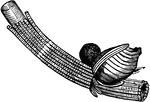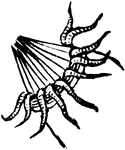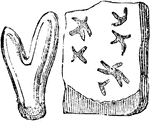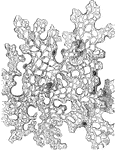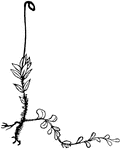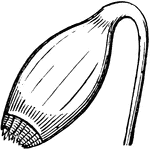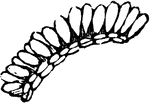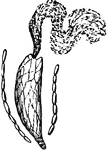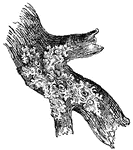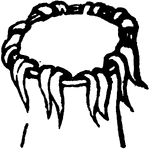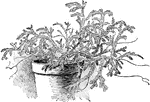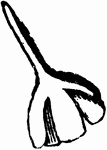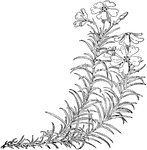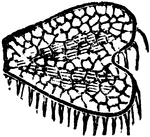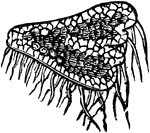The Mosses and Lichens ClipArt gallery offers 139 illustrations of numerous types of mosses and lichens. Mosses and lichens are part of the taxonomic division known as bryophyes, or non-vascular land plants.

Flower of a Moss
An illustration of the flower of a moss: ar, archegonium; an, antheridium; p, paraphysis; bl, leaf.

Funaria
This illustration shows the structure of capsule of Funaria: 5, capsule with calyptra, 5A, removed.…
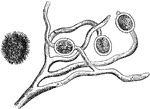
Fungus
Illustration of a fungus named Atrotogus hydnosporus. "Considered by Berkeley and others to be probably…
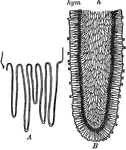
Fungus Gills
"Portions of gills of a fungus (Agaricus). A, slightly magnified; B, one of the parts of A, more magnified.…
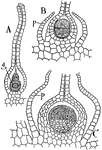
Gametospore
This illustration shows the germination of the gametospore: A, section of a mature archegonium with…

Ground Pine
"1. Spore-case of Lycopodium denticulatum opened; 2. antheridium; 3. spore." -Lindley, 1853
Hair Cap Moss
Hair cap moss is the common name of polytrichum commune. The spore cases or capsules arise from the…

Pleospora Herbarum
An image depicting a Pleospora herbarum in macrospore stage. A, Conidium on Stalk; b, Conidium after…
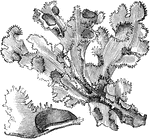
Iceland Moss
"Cetraria islandica: a a. its shields; b. a shield magnified and divided vertically." -Lindley, 1853
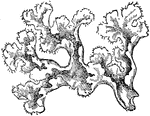
Iceland Moss
celand moss (Cetraria islandica) is a lichen whose erect or ascending foliaceous habit gives it something…

Jungermannia
Fructification of a Jungermannia, its cellular spore-stalk, surrounded at base by some of the leaves,…

Leaf Lichen
"A greatly magnified view of a perpendicular section of Parmelia aipolia, showing the thecae in the…

Lichen
"1. Shields of Variolaria amara; 2, a portion of the thallus of the same plant." -Lindley, 1853

Lichens
An order of flowerless or cryptogamous plants. All plants are classified as belonging to the flowering…

Lichens
A stone on which various Lichens are growing, such as (passing from left to right) a Parmelia, a Sticta,…

Leafy Liverwort
"A leafy liverwort (Porella navicularis). Male plant, about natural size." -Gager, 1916
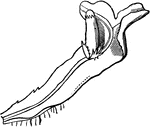
Liverworts
One of the frondose Liverworts, Steetzia, otherwise like a Jungermannia; the spore-case not yet protruded…
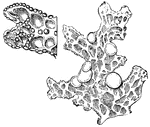
Tree Lungwort
"3. a piece of the thallus of Sticta pulmonacea, with lacunae and soredia; 4. thallus of the same, bearing…
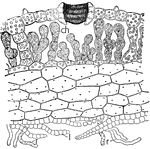
Marchantia
This illustration shows a section through the center of the thallus of Marchantia, showing one of the…

Mnium
Mnium cuspidatum's spore-case, with top of stalk, focusing on the lid and outside of the peristome.

Mnium
Antheridia and a pistillidium of the Mnium cuspidatum, at the end of a stem of same plant, the leaves…
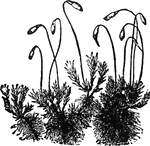
Moss
"Mosses are a class of small flowerless plants, important in the economy of nature, and of great interest…
Moss
"Mosses are a class of small flowerless plants, important in the economy of nature, and of great interest…

Moss
"Mosses are a class of small flowerless plants, important in the economy of nature, and of great interest…

Hair-Cap Moss
"Hair-cap moss (Polytrichum commune). A, male plant; B, same, proliferating; C, female plant, bearing…
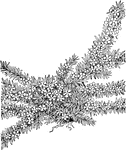
Pyxie Moss
Of the Diapensia family (Diapensiaceae), pyxie moss (Pyxidanthera barbulata) and an "enlarged blossom…
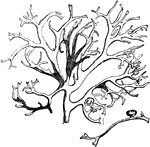
Tree Moss Bearing an Apothecium
The tree moss (Psuedevernia furfuracea) is a fungus that grows on the bark of firs and pines, here showing…

Mycelium
This illustration shows an enlarged view of the mycelium, ascocarp, etc., of one of the mildews, Erysiphe:…

Phagiochila
Plagiochila is a large, common, and widespread genus of liverworts in order Jungermanniales. It is a…

Potato rot
Illustration of a potato infested with Peronospora infestans also known as 'potato-rot' observed from…

Resurrection Plant
The fertile plant of the Resurrection Plant (Selaginella lepidophylla), a spikemoss which lives in deserts.
